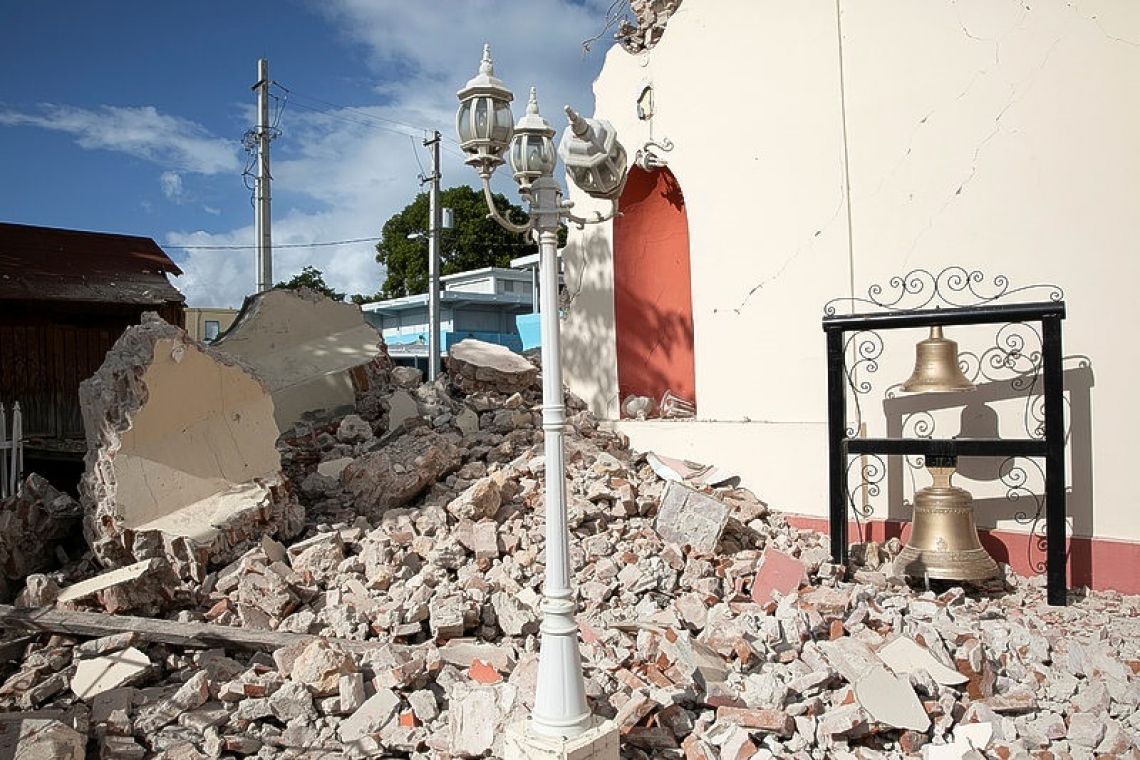A view of a damaged church after the earthquake in Guayanilla, Puerto Rico.
PHILIPSBURG--St. Maarten National Disaster Coordinator and Fire Chief Clive Richardson said in a press release from the Office of Disaster Management (ODM) on Sunday that the continued earthquake activity along the southern coast of Puerto Rico is causing some anxiety throughout the St. Maarten community.
The United States (US) National Weather Service (NWS) Pacific Tsunami Warning Center issued a “Tsunami Information Statement” on Saturday morning related to a 5.9 magnitude earthquake off the coast of Puerto Rico.
“Based on all available data … there is no significant tsunami threat from this earthquake; however, there is a very small possibility of tsunami waves along coasts located nearest the epicentre,” according to the statement.
The US National Oceanic and Atmospheric Administration (NOAA) describes a tsunami as a series of large ocean waves generated by sudden displacements in the sea floor, landslides, or volcanic activity.
“In the deep ocean, the tsunami wave may only be a few inches high. The tsunami wave may come gently ashore or may increase in height to become a fast-moving wall of turbulent water several meters high. Although a tsunami cannot be prevented, the impact of a tsunami can be mitigated through community preparedness, timely warnings, and effective response,” according to NOAA.
“For a destructive force such as a tsunami, the only way is to be prepared. The Caribbean region is a seismic zone and there are exposed coastal areas,” said Richardson.
While tsunamis cannot be prevented, the ODM recommends downloading government’s “Disaster Prep Sint Maarten” app, which is available from the Google Play Store.
“The disaster app has been designed to provide pertinent information on disaster preparedness, [and – Ed.] give regular updates and alerts on emergencies that are taking place on the island.
“After downloading the app, go to the ‘Disasters and risks’ tab and then select ‘Tsunami’, where you will find information on what steps you can take before a tsunami, during a tsunami, and after a tsunami – that could save your life and the lives of your family and friends. It’s always best to be prepared.
“When a tsunami warning is issued, ‘take action!’ Move to high ground [and] stay out of the water, away from beaches and waterways,” said ODM.
According to NOAA, a natural tsunami warning may be your first, best and/or only warning that a tsunami is on its way. Natural tsunami warnings include strong or long earthquakes, a loud roar (like a train or an airplane) coming from the ocean, and unusual ocean behaviour.
“The ocean could look like a fast-rising flood or a wall of water. Or, it could drain away suddenly, showing the ocean floor, reefs and fish like a very low tide. If you experience any of these warnings, even just one, a tsunami could be coming,” said ODM.
According to ODM, persons should also make an emergency plan, including a family communication plan, and put together a portable disaster supplies kit that is easily accessible and contains basic items a person and his/her family may need in an emergency.
“Include your pets in all your preparedness efforts. Since you do not know where you will be when disaster strikes, prepare kits for work and your car too. Meet with your family to discuss the plan and why you need to prepare for a disaster. Practice your plan and keep it up to date.
“Be a role model. Share your knowledge and plans with friends and neighbours so they can prepare themselves and their loved ones,” concluded ODM.







